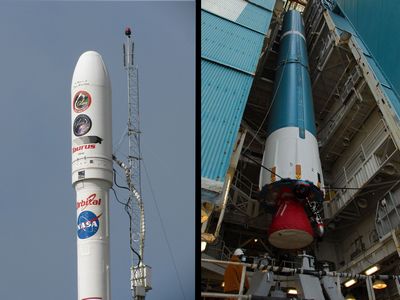
NASA's Glory spacecraft sets atop its Taurus XL rocket at California's Vandenberg Air Force Base, awaiting its scheduled March 4 launch, while at right, nearby at Vandenberg, erection of the Delta II rocket that will deliver NASA's Aquarius spacecraft to orbit this June has begun.
In a rare event, two NASA launch vehicles currently rise above California's Vandenberg Air Force Base, as NASA's two, new Earth monitoring satellites, Glory and Aquarius, ready for their respective launches.
Both the Glory spacecraft and Taurus XL rocket are ready for launch Friday, March 4, at 2:09:43 a.m. PST (5:09:43 a.m. EST). The weather forecast is 100 percent "go," with the possibility of some fog and a low ceiling not expected to be an issue.
The liftoff from Vandenberg Air Force Base (Launch Complex 576-E) is targeted for the middle of a 48-second launch window. Spacecraft separation will occur 13 minutes after launch.
Technical issues with ground support equipment for the Taurus XL launch vehicle led to the scrub of the first launch attempt on Feb. 23.
Data from the Glory mission will allow scientists to better understand how the sun and tiny atmospheric particles called aerosols affect Earth's climate. Both aerosols and solar energy influence the planet's energy budget -- the amount of energy entering and exiting Earth's atmosphere.
See the website for more details.
http://www.nasa.gov/topics/earth/features/glory20110303.html(SY)
